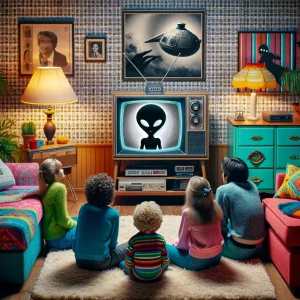The Best Fluffy Pancakes recipe you will fall in love with. Full of tips and tricks to help you make the best pancakes.

Ah, the 80s. It was a time of big hair, shoulder pads, and even bigger televisions. This era was when cable TV came booming into our living rooms, changing how we consumed entertainment and culture forever. From MAS*H to MTV, cable TV in the 80s brought us some of the most memorable moments in TV history. As we journey back in time, let’s explore cable television’s birth, expansion, and legacy and how it set the stage for the rise of today’s streaming era.
The Birth of Cable TV
The First Cable Company
In the waning years of the 70s, a revolutionary event reshaped the television landscape forever. A joint venture between Warner Communications and American Express, aptly named Warner-Amex Satellite Entertainment, broke new ground with the launch of QUBE in Columbus, Ohio.
Despite its short lifespan, this advanced interactive TV system was the metaphorical ‘big bang’ that sparked the cable television universe. As we moved into the decade of synth music and neon, the cable TV sector flourished like never before.
The turning point came with enacting the Cable Communications Policy Act of 1984. This crucial legislation lifted many regulatory shackles, paving the way for an explosive expansion of cable television. The United States was soon dotted with burgeoning cable companies, each striving to pipe a unique blend of programming into the heart of American homes.
These companies transformed dull living rooms into dynamic entertainment hubs, offering citizens a front-row seat to various shows, news, sports, and more. Thus, the 80s marked the dawn of a new television era, setting the stage for the colossal entertainment industry we know today.
The First Cable Channels
The powerhouse trio of ABC, CBS, and NBC no longer monopolized the television landscape. Fresh faces on the scene, such as CNN, ESPN, and MTV, started staking their claims, providing 24/7 coverage of news, sports, and music.
CNN, launched by Ted Turner in 1980, revolutionized the news landscape with its 24-hour news cycle. ESPN, the sports network that came to life in 1979, transformed into a household name by serving up non-stop sports coverage, from baseball and football to more niche sports, giving every sports enthusiast something to tune into. And who could forget MTV? In 1981, MTV redefined the music industry by popularizing music videos, turning musicians into visual artists, and catapulting them to superstardom.
Cable TV in the 80s did more than provide entertainment—it initiated a seismic cultural shift. It catered to diverse interests and demographics with specialized programming, changing how we perceived and interacted with the world. It gave us the freedom to choose what we wanted to watch when we wanted to watch it, shaping our viewing habits in ways that still resonate in today’s streaming-dominated era.
The Revolutionary 1980 Cable Box and On TV Box
The 1980s saw the introduction of groundbreaking tech devices that would forever change our television viewing experience – the quintessential 1980 cable box and the On TV box. These devices were more than just bricks of plastic and metal; they were symbols of the profound shift in entertainment. The remote control, a now ubiquitous accessory, was not just a channel flipper but a powerful tool that put the power of television consumption into viewers’ hands.
With the ability to sift through many cable TV channels at their fingertips, viewers were no longer passive recipients of a one-way broadcast. They now had the privilege of creating their personalized viewing experience, choosing what to watch and when. This was a massive departure from traditional broadcasting networks’ rigid, scheduled programming.
With its flexible, interactive expertise, Cable became the preferred choice for American households, leading to a significant surge in cable TV subscriptions and viewership. The 80s marked the era when consumers began demanding more control, diversity, and personalization in their TV viewing habits.
The Expansion of Cable TV in the 80s
The Rise of Specialized Channels in the 80s
The 1980s witnessed an unprecedented proliferation of new channels, further adding to the allure of cable TV. This was when channels like Nickelodeon, BET, Comedy Central, and the Discovery Channel sought to cater to specific viewer interests. They began to etch their unique identities in the television landscape. Catering to a diverse array of tastes, these channels did not just entertain viewers; they played significant roles in shaping societal trends and, in essence, the fabric of pop culture.
Nickelodeon, for instance, became the go-to channel for children’s programming, with iconic shows such as ‘Rugrats’ and ‘Hey Arnold!’, bringing animated joy to the younger generation. On the other spectrum, BET emerged as a platform that celebrated African-American culture, providing a unique space for its representation on television.
Comedy Central’s stellar lineup of comedic shows and stand-ups became synonymous with laughter. At the same time, the Discovery Channel quenched the audience’s thirst for knowledge with its informative documentaries on nature, science, and history.
Even more specialized programming began to emerge, turning cable TV into an array of entertainment options. Fitness buffs found a home in ESPN’s fitness shows, and music lovers got their daily dose of chart-topping hits on MTV. The 80s marked an era where viewers could find something on cable TV that resonated with their unique interests and preferences, effectively personalizing the viewing experience.
Cable Box 1980s: A Technological Revolution
In the 1980s, the humble cable box underwent transformative advancements that altered the landscape of televised entertainment and set the foundation for future cable television offerings. The decade bore witness to the introduction of innovative features now taken for granted—such as on-screen programming guides that allowed viewers to effortlessly browse through the multitude of channels and schedule their viewing times.
Even more striking was the advent of pay-per-view events, a revolutionary concept that allowed viewers to access exclusive content for a fee, marking the inception of personalized and on-demand viewing. This game-changer gave viewers the power to watch special events, like boxing matches or concerts, live from the comfort of their homes.
The 80s also saw aggressive marketing strategies employed by cable companies to drive growth and maximize profits. Subscribers were enticed with offers of premium movie channels bundled with their regular cable subscriptions, offering unparalleled variety and access to a vast library of films. Sophisticated packages were crafted to cater to varying consumer needs and budgets, ushering in a new era of customizable television.
This unique combination of technological advancements and strategic marketing set the stage for the explosive growth of cable television that characterized this unforgettable decade.
First Cable Network
One of the pioneers leading the cable TV revolution was none other than the Turner Broadcasting System, masterminded by the influential media titan Ted Turner. The inception of this innovative network lit the spark for the impending cable TV explosion, introducing viewers to the appeal of exclusive cable content and setting the blueprint for the industry’s evolutionary trajectory.
Turner’s flagship venture, the Superstation TBS, carved out a niche with a distinctive programming mix that appealed to a broad audience.
It served a hearty menu of timeless cinema classics and rerun marathons of top-rated sitcoms, a formula that quickly found favor amongst viewers. This successful strategy not only amplified the popularity of TBS but also solidified its standing as a trailblazer in the dynamic landscape of 80s cable television.
Transition into the 90s
Cable Companies in the 90s
As the vibrant 80s gave way to the dawn of the 90s, the landscape of cable television faced a seismic shift sparked by intensified competition and groundbreaking technological innovations. Powerhouse entities like Time Warner Cable and Comcast emerged from the crowd, making their mark by introducing pioneering developments such as high-speed broadband internet and cutting-edge digital cable that enhanced picture quality and offered a more comprehensive array of channels.
The 90s proved a pivotal period for the cable industry, as it witnessed a robust escalation in revenue and viewer engagement. This decade laid the groundwork for the evolution of cable TV, driving it towards the multifaceted, high-definition, and on-demand experience we are familiar with today.
90s Cable Companies: A New Era
As the 90s rolled in, cable companies faced a need to evolve and remain pertinent in a rapidly changing environment. They embraced the rise of new technologies and adapted to the burgeoning demands of the modern viewer, introducing groundbreaking services such as high-definition programming and broadband internet, technologies that would later become commonplace in homes across the globe in the 21st century.
To further assert their dominance in the market, they widened their service offerings to include interactive features like video-on-demand and subscription-based television, revolutionizing the way viewers consumed media. These changes in the cable industry during the 90s represented a significant leap towards the emergence of a diversified, personalized, and high-quality television experience that viewers enjoy today.
The Legacy of Cable TV
The Cultural Impact
Cable television indelibly shaped the cultural zeitgeist, imprinting popular culture, music, and entertainment. It served as the birthplace for innovative genres and groundbreaking viewing formats that persistently mold our media consumption patterns to this day.
Classic television shows like the quirky and eccentric world of ‘The Simpsons’ and the comedic genius of ‘Seinfeld’ found their origins in the cable TV era of the 80s. These shows didn’t merely entertain; they transformed the landscape of television, shaping our understanding of humor, satire, and narrative storytelling.
Furthermore, cable TV was instrumental in the rise of music videos as a powerful artistic medium, with MTV leading the charge. Music videos became an integral part of the music industry, offering musicians a visual platform to express their creativity and connect with fans on a deeper level.
The 80s was a pivotal era for music videos, with artists pushing boundaries and creating iconic videos that have stood the test of time. Cable TV, especially in the 80s, didn’t just revolutionize how we consumed entertainment; it fundamentally changed how we experienced and interacted with music, television, and culture at large.
The Technological Impact
Cable TV’s technological innovations laid the foundation for modern streaming and digital media. The advent of digital cable boxes, on-demand programming, and broadband internet during the 80s and 90s paved the way for today’s streaming platforms. From Netflix to Hulu, cable TV’s legacy will continue to influence the future of media consumption.
The 80s were a golden era for cable TV. With its triumphant expansion and technological innovations, cable television transformed our living rooms forever. From MTV to QUBE, this era marked the birth of an industry that continues to shape how we consume entertainment today. So let’s raise a glass to cable TV in the 80s and its everlasting legacy.
Cable TV in the 80s and 90s was more than just a medium – a cultural phenomenon that transformed our living rooms and reshaped entertainment culture. Its legacy is still evident as we navigate the ever-expanding universe of digital media. As we switch from channel surfing to binge-watching, let’s not forget the cable TV era – a blast from the past that continues to echo in our present.
Frequently Asked Questions
What made cable TV in the 80s unique?
Cable TV in the 80s stood out for its innovative programming and technological advancements. It introduced viewers to exclusive content, featured timeless cinema classics, and allowed for rerun marathons of top-rated sitcoms. This era also saw the advent of music videos as a powerful artistic medium, with MTV leading the way.
How did cable TV change in the 90s?
The 90s was a period of intense competition and groundbreaking innovation in the cable TV industry. Companies like Time Warner Cable and Comcast made significant strides, introducing high-speed broadband internet and digital cable. Cable companies also began to offer interactive features like video-on-demand and subscription-based television.
What impact did cable TV have on culture?
Cable TV profoundly impacted popular culture, music, and overall entertainment. Classic shows like ‘The Simpsons’ and ‘Seinfeld,’ born in the cable TV era, shaped our understanding of humor, satire, and narrative storytelling. Music videos, especially those from the 80s, fundamentally changed how we experience and interact with music.
How did cable TV influence modern streaming and digital media?
Cable TV’s technological innovations set the stage for today’s streaming platforms. The introduction of digital cable, on-demand programming, and broadband internet during the 80s and 90s paved the way for platforms like Netflix and Hulu.






